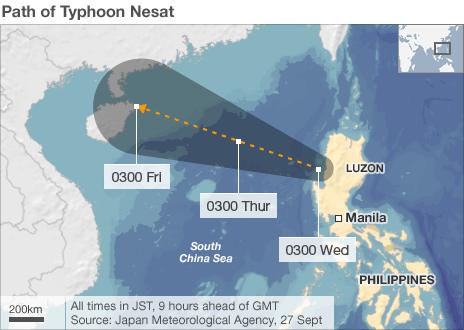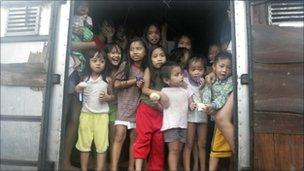Powerful Typhoon Nesat hits Philippines
- Published
Kate McGeown reports from the island of Luzon
A powerful typhoon has struck the Philippines, triggering floods and cutting power in the capital, Manila and throughout the main island, Luzon.
At least 16 people have been killed, including several children, most of them in Manila.
Typhoon Nesat also forced the closure of the Philippine Stock Exchange and the US embassy, and the ground floor of Manila's main hospital was flooded.
More than 100,000 people in Albay province were ordered to evacuate.
And thousands of residents of the capital flocked to school buildings for shelter - many carrying pets, TV sets, bags of clothes and other belongings.
However, caretaker Banny Domanais arrived at a school in the Marikina district with his wife and three daughters having left his possessions behind.
"We can replace things, but not people's lives," he said.
Witnesses said flooding in parts of Manila was the worst for decades.
The eye of the storm has blown out into the South China Sea, and is expected to hit southern China later in the week.
Nesat made landfall just before dawn on Tuesday in the eastern Isabela and Aurora provinces on the Pacific coast.
The storm, with a diameter of 650km (400 miles), hit land carrying gusts of wind up to 170km/h.
Many roads have been flooded and flights cancelled, and local media are urging people against non-essential travel, says the BBC's Kate McGeown in Zambales province, Luzon.
Officials said 16 people had been confirmed dead in the storm, among them:
A one-year-old boy who drowned after falling into a creek in the central island province of Catanduanes
A mother and child whose house was hit by a falling tree in Manila
Four people crushed by a collapsing wall in Manila
Four girls hit by falling trees north of Manila
An adult and three children crushed in a collapsed building in a northern Manila suburb

Reporters described huge waves crashing into Manila Bay's seawall, with water overflowing into Roxas Boulevard and flooding streets and parks around the US embassy, which was evacuated.
The ground floor of Manila hospital was flooded, and staff were forced to move patients to the first floor.
"We've heard of Manila Hospital being flooded, but we're struggling to reach the area even though we've co-ordinated with them already to help in an evacuation plan," Philippine National Red Cross secretary general Gwen Pang told AFP.
A five-star hotel was also evacuated, reports said.
Meanwhile, thousands of residents living inland along the Marikana river were evacuated as it threatened to overflow.
Government offices, schools and universities were closed.
In Isabela province, residents have been evacuated from four coastal towns under threat from storm surges.

Tens of thousands of people are being evacuated in Luzon
Earlier, about 110,000 people in several towns of the Albay province were ordered to leave their homes and seek shelter elsewhere.
"We can't manage typhoons, but we can manage their effects," provincial Governor Joey Salceda was quoted as saying by the Associated Press.
The Philippines suffers frequent typhoons, about 20 a year, but Nesat is thought to be the largest this year.
It comes almost exactly two years after Typhoon Ketsana killed more than 400 people.
- Published28 September 2011
- Published27 July 2011